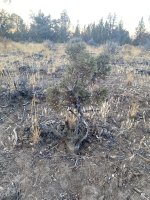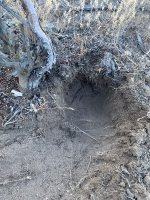I_I_am_not_a_cat
Yamadori
Does anyone here have experience with using the HBR method on a yamadori to improve the chances of success? I came across this nice little Western Juniper that I would like to collect but as usual around these parts there is no rootball to speak of in the sandy soil.
I dug around the base and found that the soil is only about 6 inches deep, there is at least one thumb sized root running along the bedrock out to one side but there could also be roots going down into cracks--I didn't want to disturb it too much. There are some smaller roots close to the trunk, as you can see in the 2nd picture. There are also a lot of fine roots, but it is unclear to me if those are from the tree or from the (minimal) ground cover.
I know that the general advice is to look for trees growing in pockets where you can easily extract most of the roots, but I am not finding that around here. The bedrock is too easily broken. Yes, I have looked at thousands of trees over the past couple of years and only once did I find something close to that scenario.
Would it improve my chances of success if I add bonsai soil to the one side that I dug yesterday?
Any suggestions would be appreciated. I am down for an experiment--this area is BLM (I have a permit) and I go there often to walk my dog off-leash.
On a related note, a friend randomly dropped off 10 bags of coco-perlite mix and asked if I could use it for bonsai. I am assuming not, but wondered if anyone else has used it and how.
I dug around the base and found that the soil is only about 6 inches deep, there is at least one thumb sized root running along the bedrock out to one side but there could also be roots going down into cracks--I didn't want to disturb it too much. There are some smaller roots close to the trunk, as you can see in the 2nd picture. There are also a lot of fine roots, but it is unclear to me if those are from the tree or from the (minimal) ground cover.
I know that the general advice is to look for trees growing in pockets where you can easily extract most of the roots, but I am not finding that around here. The bedrock is too easily broken. Yes, I have looked at thousands of trees over the past couple of years and only once did I find something close to that scenario.
Would it improve my chances of success if I add bonsai soil to the one side that I dug yesterday?
Any suggestions would be appreciated. I am down for an experiment--this area is BLM (I have a permit) and I go there often to walk my dog off-leash.
On a related note, a friend randomly dropped off 10 bags of coco-perlite mix and asked if I could use it for bonsai. I am assuming not, but wondered if anyone else has used it and how.






